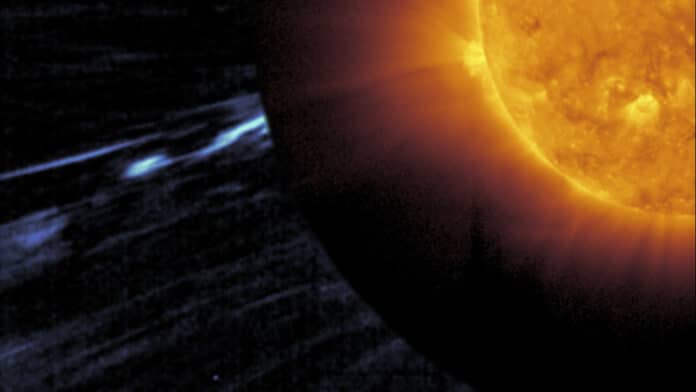Solar switchback is sudden and large deflections of the solar wind’s magnetic field. The switchbacks’ formation mechanism and sources are still unresolved. Now, the ESA/NASA Solar Orbiter spacecraft has found compelling clues as to the origin of these magnetic switchbacks.
Solar Orbiter has made the first-ever remote sensing observation consistent with a solar switchback, providing a full view of the structure, confirming it has an S-shaped character, as predicted. Additionally, the global view offered by the data from the Solar Orbiter suggests that these quickly varying magnetic fields may have their origins close to the Sun.
Despite the fact that numerous spacecraft have passed through these mysterious regions in the past, in situ data only permit a measurement at a specific point and time. As a result, the switchback’s structure and shape must be deduced from measurements of the plasma and magnetic field properties recorded at a single location.
The solar switchbacks were found to occur frequently after the launch of NASA’s Parker Solar Probe in 2018. This strongly suggested that the rapid magnetic field reversals occur more regularly close to the Sun and raised the possibility that magnetic field kinks bring them on in the shape of an S.
Switchbacks is the name given to the phenomenon due to its perplexing behavior. As to how these might form, several theories were put forth.
Credit: ESA & NASA/Solar Orbiter/Metis Teams; D. Telloni et al. (2022)
On 25 March 2022, Solar Orbiter was just a day away from a close pass of the Sun – bringing it within the orbit of planet Mercury – and its Metis instrument was taking data. Metis blocks out the bright glare of light from the Sun’s surface and takes pictures of the corona.
At around 20:39 UT, Metis captured an image of the solar corona that showed a distorted S-shaped kink in the coronal plasma. According to Daniele Telloni, National Institute for Astrophysics – Astrophysical Observatory of Torino, Italy- it must be a solar switchback.
Credits: ESA
The image was later compared with an image taken by Solar Orbiter’s Extreme Ultraviolet Imager (EUI) instrument. It was found that the candidate switchback was taking place above an active region cataloged as AR 12972. Further analysis demonstrated that the speed of the plasma above this region was very slow, as would be expected from an active region that has yet to release its stored energy.
Daniele recognized this as resembling the switchback generating mechanism presented by Prof. Gary Zank of the University of Alabama in Huntsville, USA. The theory examined the interactions between various magnetic areas near the Sun’s surface.
Daniele and Gary proved that switchbacks occur when there is an interaction between a region of open field lines and a region of closed field lines. As the field lines crowd together, they can reconnect into more stable configurations. Rather like cracking a whip, this releases energy and sets an S-shaped disturbance traveling off into space, which a passing spacecraft would record as a switchback.
Gary Zank said, “The first image from Metis that Daniele showed suggested to me almost immediately the cartoons we had drawn in developing the mathematical model for a switchback. Of course, the first image was just a snapshot, and we had to temper our enthusiasm until we had used the excellent Metis coverage to extract temporal information and do a more detailed spectral analysis of the images themselves. The results proved to be spectacular!”
Scientists also built a computer model of behavior. They found that their results bore a striking resemblance to the Metis image, especially after they included calculations for how the structure would elongate during its propagation outwards through the solar corona.
Daniele said, “I would say that this first image of a magnetic switchback in the solar corona has revealed the mystery of their origin.”
“The next step is to try to statistically link switchbacks observed in situ with their source regions on the Sun. In other words, to have a spacecraft fly through the magnetic reversal and be able to see what’s happened on the solar surface. This is exactly the kind of linkage science that Solar Orbiter was designed to do, but it does not necessarily mean that Solar Orbiter needs to fly through the switchback. It could be another spacecraft, such as the Parker Solar Probe. As long as the in-situ data and remote sensing data are concurrent, Daniele can perform the correlation.”
Daniel Müller, ESA Project Scientist for Solar Orbiter, said, “This is exactly the kind of result we were hoping for with Solar Orbiter. We obtain more data from our suite of ten instruments with every orbit. Based on results like this one, we will fine-tune the observations planned for the Solar Orbiter’s next solar encounter to understand how the Sun connects to the wider magnetic environment of the Solar System. This was Solar Orbiter’s very first close pass to the Sun, so we expect many more exciting results to come.”
Journal Reference:
- Daniele Telloni, Gary P. Zank et al. Observation of a Magnetic Switchback in the Solar Corona. The Astrophysical Journal Letters 936 L25. DOI: 10.3847/2041-8213/ac8104
